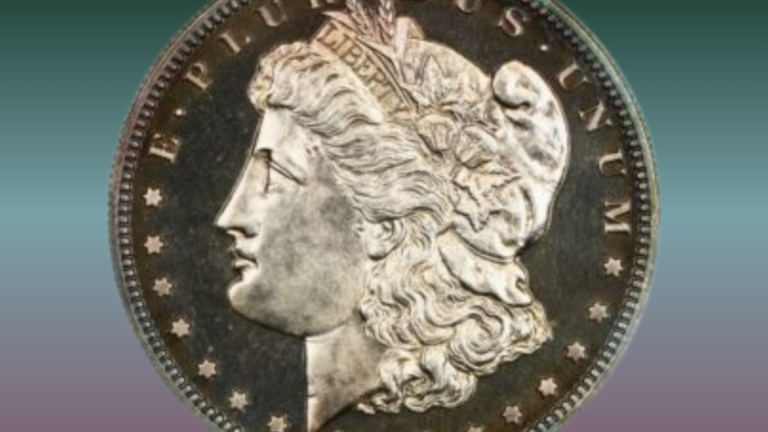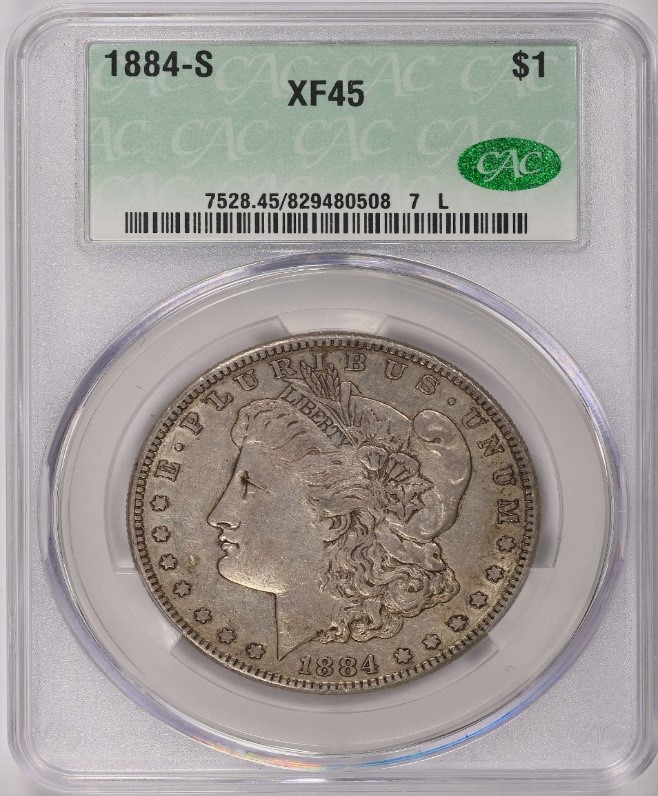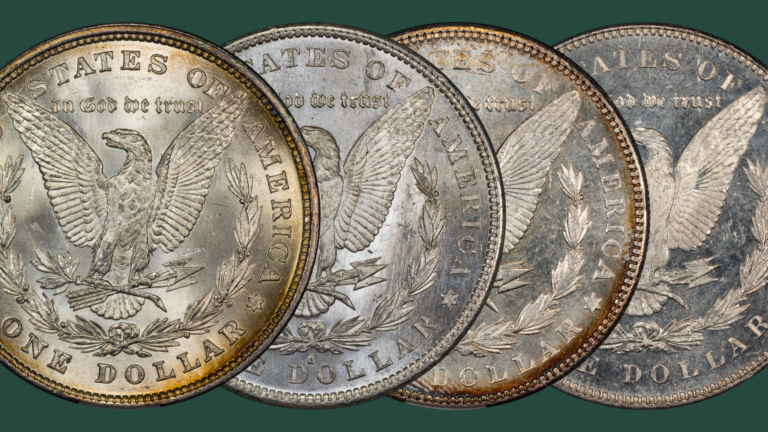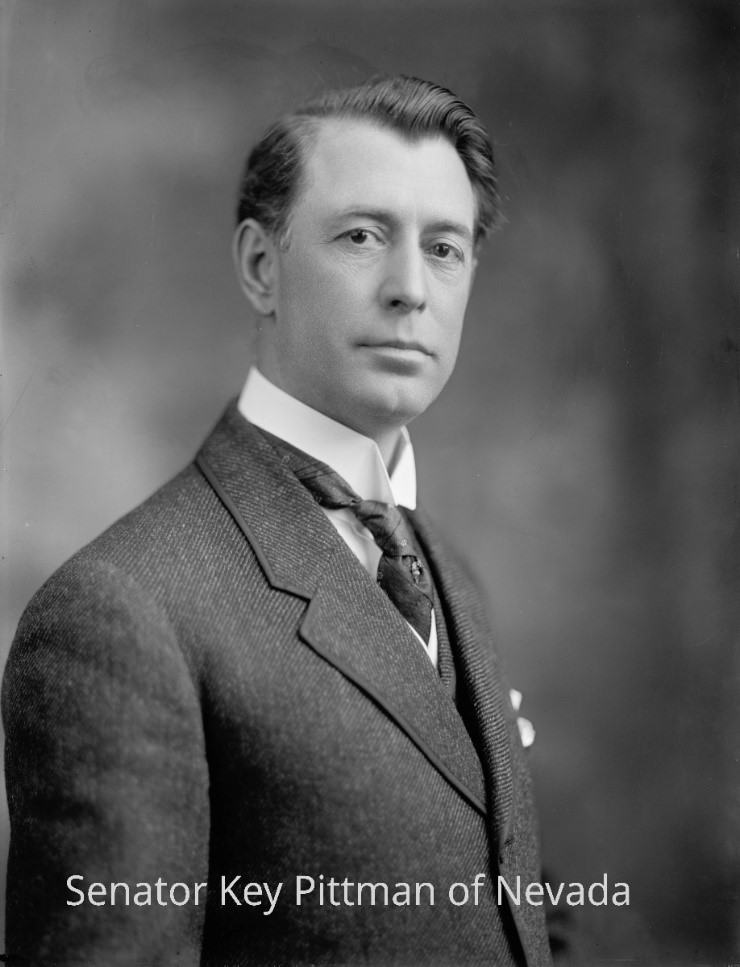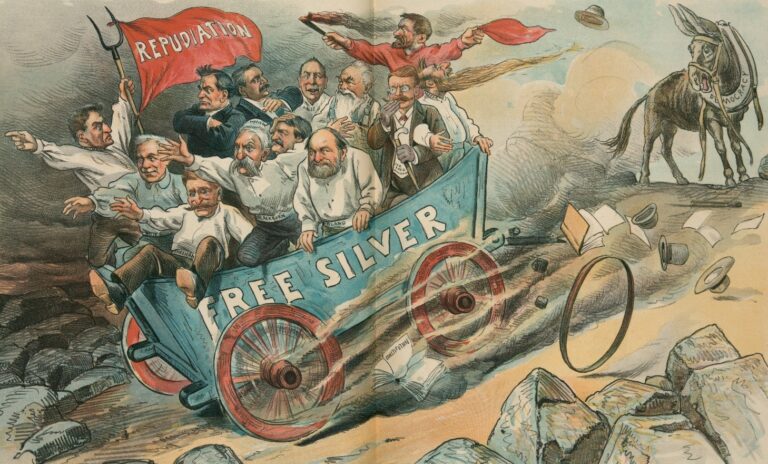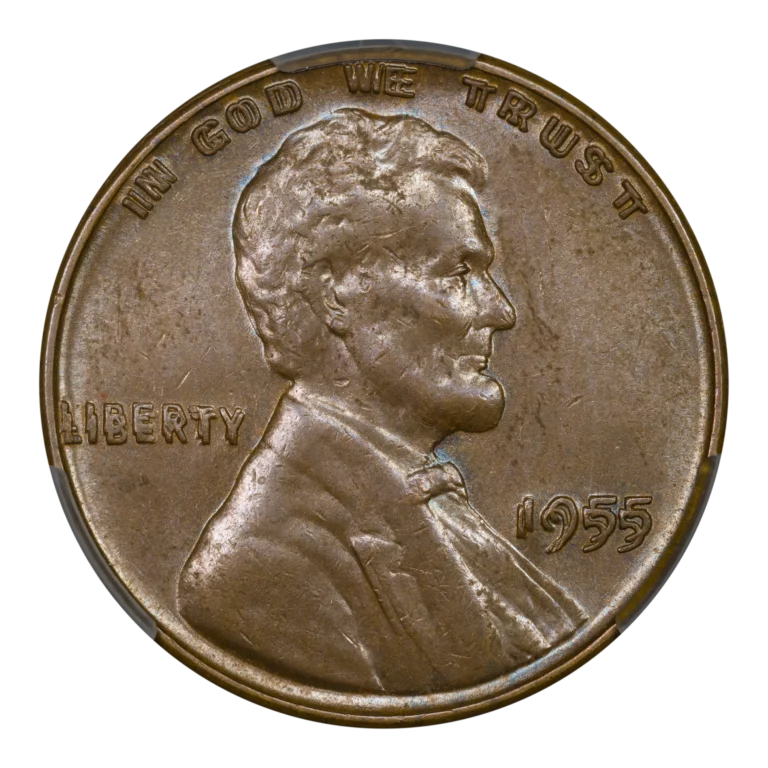by Greg Reynolds
This is the second part of a guide to assembling a type set of classic U.S. half dollars in Very Fine (VF) to Almost Uncirculated (AU) grades. In the part about types of classic U.S. half dollars dating from 1866 onward, a list of design types was provided. Here, half dollars of types from the 1790s to the early 1860s are discussed.
Type sets are not complicated, they are interesting and are fun to assemble. A type set requires just one coin of each applicable design type.
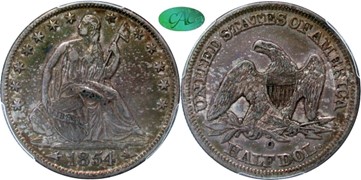
In this series of collecting guides, there are separate discussions about collecting Choice Uncirculated (MS-63 to MS-64) and gem quality (MS-65 and higher) half dollars by design type. There is also a separate guide to collecting Proof halves by design type. These type collecting guides will be accompanied by guides to collecting classic U.S. half dollars ‘by date’ (including mint locations).
Some collectors who assemble type sets of half dollars will later decide to collect one or more types ‘by date.’ Other collectors will shift their attention to another denomination or an entirely different project. For a collector who is unsure as to how to proceed, collecting by design type is a logical, educational and enjoyable approach.
Design types are listed in reverse order because most collectors starting a type set will benefit by beginning with representatives of later types. It is usually easier to find very appealing examples of later types. Furthermore, later type coins of the same denomination, half dollars in this case, tend to be less expensive on average than earlier type coins in the same grade ranges. A collector may wish to learn more about half dollars, market levels and the coin business before spending a large part of the cost of a type set. Indeed, collectors tend to learn while collecting.
Type #9 – Liberty Seated, No Motto, With Arrows, No Rays (1854-55)
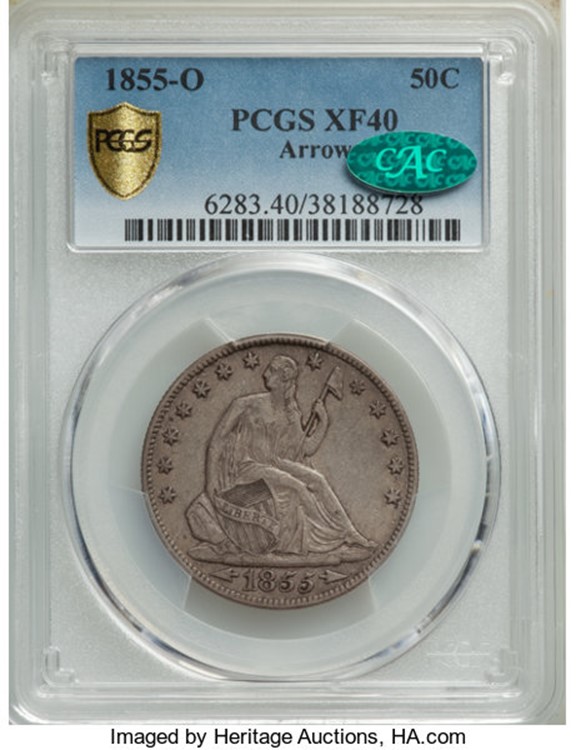
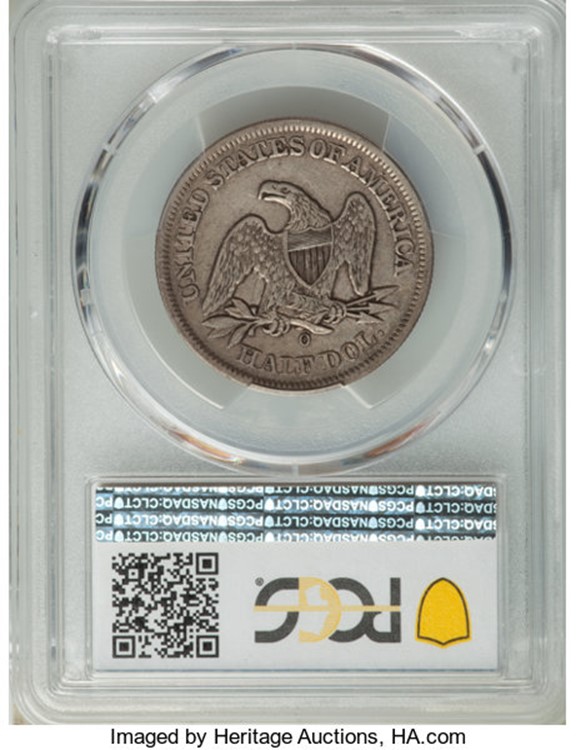
For 1854 and 1855 half dollars and quarters, the design features arrows but no rays. As the rays and their absence are so distinct and noticeable, coins with arrows and without rays constitute a design type that is different from the ‘Arrows & Rays’ half dollar issue of 1853 (Type #8).
The specifications for the weight and fineness (silver percentage) of the coins remained the same after the rays were deleted from the design before 1854 and after the arrows were dropped before the issues of 1856. The Coinage Act of 1853 required half dollars to be lighter in weight than the Liberty Seated halves that were minted from 1839 until some point early in 1853. The arrows reminded consumers that the relatively new half dollars contained less silver, so consumers would spend them rather than hoard them.
It is not difficult to find an XF to AU grade, 1854 or 1855 Liberty Seated half dollar. In June 2018, GreatCollections sold a CAC approved, NGC graded XF-45 1854-O half dollar for $191.25. In January 2021, GFRC sold a CAC approved, NGC graded AU-55 1854 for $395. In June 2020, GFRC sold a CAC approved, PCGS graded AU-55 1854-O for $410.
An appealing New Orleans Mint coin of this short lived design type is not very costly. Circulated, CAC approved coins become available from time to time.
In June 2018, GreatCollections sold a CAC approved, PCGS graded VF-35 1855-O half for $148.50. In August 2020, the firm of Gerry Fortin sold a CAC approved, PCGS graded XF-45 1854-O half for $285.
As of Sept. 17, 2021, CAC has approved twenty-seven 1854 halves, forty-nine 1854-O halves, just nine 1855 halves, and thirty-three 1855-O halves, in grades below AU-55. There are others that would be approved if submitted. It is not difficult to acquire a pleasant VF-20 to AU-53 grade half of this design type.
Type #8 – Liberty Seated, Arrows & Rays (1853 only)
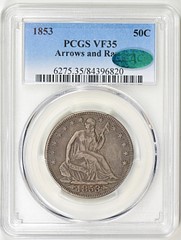
For silver denominations except silver dollars and Three Cent Silvers, the standard for the silver content of each coin to be struck was reduced by the Coinage Act of 1853. After large deposits of gold were discovered in the Western United States during the late 1840s and early 1850s, the relative price of silver rose. As a consequence, people started hoarding or trading silver coins rather than spending them.
To encourage people to spend silver coins, the respective amounts of silver in half dimes, dimes, quarters and half dollars were decreased. It is unclear to me as to why the rays were removed from the design while the arrows remained for two more years. Perhaps the addition of rays caused the reverse (back) designs of quarters and halves to become too crowded with design elements, and metal was not properly flowing into the recesses of the reverse dies while coins were struck? Did the presses have to be adjusted in a way that U.S. Mint personnel found to be time consuming or counter-productive for other reasons? There is not, though, a need to analyze the reasons for design changes to enjoy assembling a set of design types.
In April 2020, GreatCollections sold a CAC approved, PCGS graded VF-35 1853 for $189. In July 2021, Heritage sold a CAC approved, PCGS graded XF-40 1853 for $288. In May 2020, the firm of David Lawrence sold a CAC approved, NGC graded AU-53 1853 half for $500. VF to AU grade representatives of this one-year type are available every year.
Type #7 – Liberty Seated, With Drapery, No Motto (1839-53, 1856-66)
Coins of this type are relatively plentiful. Even most of the ‘better dates’ are not especially expensive and true rarities are available. A collector who is unfamiliar with this type and is just seeking a type coin should probably concentrate on selecting a pleasant, naturally toned representative of one of the least scarce dates.
I have not seen the coins that I am citing here. Public sales provide information relating to market values and availability, though each coin is different. No single price realized should be taken too seriously.
In November 2018, GreatCollections sold a CAC approved XF-45 grade 1844 half dollar for $208.12. In March 2020, Heritage sold a CAC approved AU-50 grade 1844 half dollar for $288.00. In February 2019, GreatCollections sold CAC approved VF-25 grade 1846-O half for $133.01.
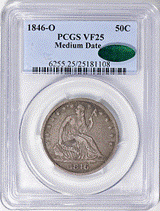
In October 2020, Heritage sold a CAC approved XF-45 grade 1847 for $360. In September 2020, Gerry Fortin Rare Coins sold a CAC approved AU-50 grade 1847 half for $450.
In October 2019, Stack’s-Bowers auctioned a CAC approved, NGC graded XF-45 1858 half dollar for $144. In February 2020, GreatCollections sold a CAC approved AU-50 grade 1861 for $283.50.
There are many CAC approved half dollars of this design type that can be found and acquired for prices in the range of $175 and $500. Collectors may take their time and be very selective.

Type #6 – Liberty Seated, No Drapery, No Motto (1839 only)
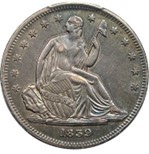
For half dollars, the differences between the ‘No Drapery’ type and the next type are much less significant than the corresponding distinctions for half dimes, dimes and quarters. It is really debatable as to whether the 1839 ‘No Drapery’ half is truly a distinct design type. By tradition, however, the 1839 ‘No Drapery’ is classified as a separate design type, and most interested collectors figure a complete type set of half dollars must include one.
In addition to a little more garment under Miss Liberty’s elbow, the boulder on which Miss Liberty is apparently sitting is much farther from the first star on the ‘With Drapery’ coins (Type #7 above). On the 1839 ‘No Drapery’ halves, the boulder is closer to the first star and the material on the boulder is different. Is Miss Liberty sitting on a blanket?
In March 2020, Stack’s-Bowers auctioned a CAC approved, PCGS graded VF-30 1839 ‘No Drapery’ half for $840. In October 2020, Gerry Fortin sold a different, perhaps better, CAC approved, PCGS graded VF-30 1839 ‘No Drapery’ half for $925.
In March 2020, Heritage sold a CAC approved XF-40 grade 1839 ‘No Drapery’ for $1320. In January 2018, the firm of David Lawrence sold a CAC approved AU-53 grade 1839 ‘No Drapery’ half for $3450.
Over the last few years, more than a few 1839 ‘No Drapery’ Liberty Seated halves in a wide range of grades have traded. It is practical to obtain a CAC approved, VF to AU grade ‘No Drapery’ half for a sensible price.
Type #5 – Gobrecht Capped Bust, ‘Reeded Edge’ (1836-39)
It is tiresome to keep hearing collectors and dealers refer to coins of this type as “Reeded Edge” half dollars. Yes, of course, it is true that coins of this type each have a reeded edge. Additionally, it is true that the Capped Bust halves of the previous type, which were minted from 1807 to 1836, are characterized by letters and symbols on their respective edges. Nevertheless, as the terms ‘Reeded Edge’ and ‘Lettered Edge’ have been used as names, collectors have become under the false impression that this is the only difference between Type #4 and Type #5.
There are many differences. The halves of type #4 dating from 1807 to 1836 were designed by John Reich. The obverse design of halves of this type (#5) was substantially changed, almost certainly by Christian Gobrecht. Indeed, the portrait of Miss Liberty is much different, clearly a new concept by a different artist.
It is logical to refer to the ‘Lettered Edge’ (1807-36) type as Reich Capped Bust halves and the ‘Reeded Edge’ (1836-39) type as Gobrecht Capped Bust halves. Moreover, due to advances in technology at mints in the U.S., the striking impressions and physical structure of Gobrecht Capped Bust halves are different. A close examination of the respective coins reveals consequences of changes in the manufacturing process.
In any event, a collector need not think about technological changes at mints in order to enjoy collecting coins. Those who are interested in the history of production techniques may wish to read material by leading historian R. W. Julian or by researchers associated with the John Reich Collectors Society.
An immediate point is that it is easy to acquire a circulated Gobrecht ‘Reeded Edge’ Capped Bust half dollar. Usually, an 1837 or an 1838 half is selected for a type set.
The denomination on the reverse is featured differently on 1836 and 1837 halves, “50 CENTS,” than it is on 1838 and 1839 halves, “HALF DOL.” These are thus subtypes. The significance of this difference is highly debatable, and opinions vary as to whether one of each denominational variety is required for a type set. It is not difficult, however, to acquire both an 1837 and an 1838 Gobrecht ‘Reeded Edge’ half dollar in VF to AU grades.
On January 24, 2021, the firm of David Lawrence sold a PCGS graded VF-20 1837 half, without a CAC sticker, for $170. On October 25, 2020, GreatCollections sold a CAC approved, PCGS graded VF-30 1837 for $244.12. On November 8, 2020, David Lawrence sold a CAC approved, PCGS graded XF-40 1837 half for $275. On August 14, 2019, Heritage sold a CAC approved, NGC graded AU-55 1837 half for $720.
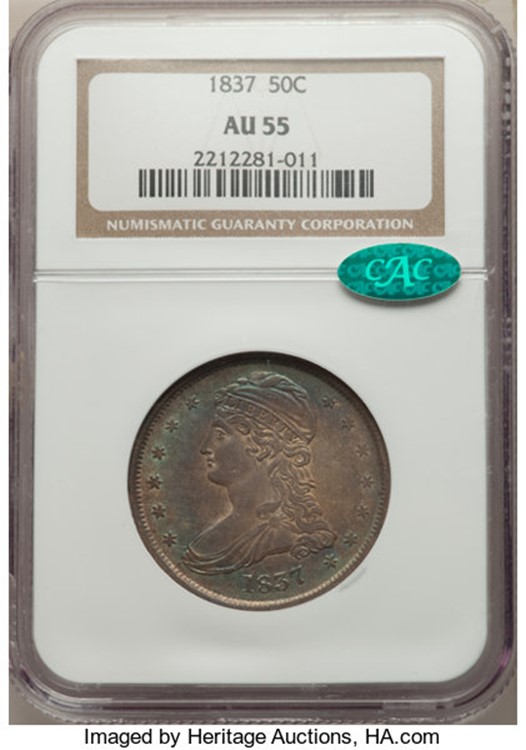
While numerous circulated 1838 half dollars were sold publicly from 2019 to 2021, not many of these were CAC approved. On January 17, 2021, GreatCollections sold a CAC approved AU-53 grade 1838 half for $472.50.
A collector who has some patience will find pleasant Very Fine to AU grade 1837 and 1838 half dollars for modest prices. Many of these trade at coin shows rather than being sold publicly in live auctions or via the Internet.
Type #4 – Reich Capped Bust, ‘Lettered Edge’ (1807-36)
Coins of this type survive in fairly large quantities. There are many dates that are not scarce.
On November 8, 2020, GreatCollections sold a CAC approved VF-20 grade 1821 half for $202.51. On October 25, 2020, GreatCollections sold three Reich halves that are pertinent to this discussion, all of which were PCGS graded and CAC approved, a VF-30 grade 1837 for $244.12, an XF-40 1827 for $205.88, and an XF-45 1832 for $243.
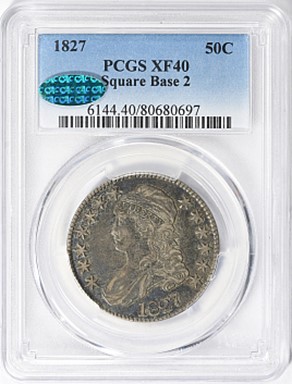
On March 21, 2021, Stack’s-Bowers sold a CAC approved AU-55 grade 1826 for $780. On March 10, 2021, Stack’s-Bowers sold a CAC approved XF-45 grade 1832 ‘Small Letters’ half for $216. On February 21, 2021, GreatCollections sold a different CAC approved XF-45 grade 1832, also of the ‘Small Letters’ major variety, for $210.38.
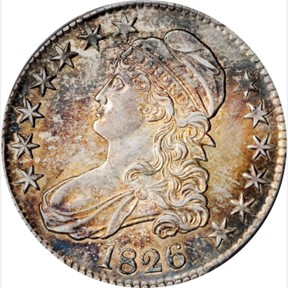
CAC approved, VF-20 or higher grade, Reich Capped Bust halves may be found for less than $200. On May 20, 2020, Stack’s-Bowers sold a CAC approved VF-35 1833 half for $132.
Type #3 – Draped Bust, Heraldic Eagle (1801-07)
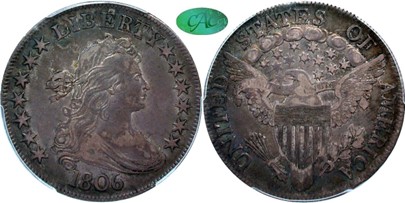
Of the Draped Bust obverse, Heraldic Eagle reverse type, the 1806 ‘Pointed 6’ and the 1807 are the two least scarce dates, though an 1805 is sometimes selected for a type set. As surviving coins of this design type tend to have problems, I suggest being careful while seeking one for a type set.
In June 2021, the firm of Gerry Fortin sold a CAC approved, NGC graded Fine-12 1806/5 overdate for $725. In August 2021, Stack’s-Bowers sold a CAC approved VF-20 grade, 1806 ‘Pointed 6, With Stem’ half dollar for $810. In May 2021, the firm of Gerry Fortin sold a CAC approved XF-40 grade 1806 ‘Pointed 6, With Stem’ half dollar for $1890. In September 2021, GreatCollections sold a CAC approved AU-50 grade 1806 ‘Pointed 6, With Stem’ half dollar for $3151.12.
In terms of design detail imparted on the respective coins, the striking of Draped Bust half dollars was often poor and uneven, though better on average than the strikes of Draped Bust, Heraldic Eagle quarters. Two Draped Bust halves may both merit the same numerical grade yet differ markedly in terms of apparent design detail. Some collectors search for coins of this type that are relatively well struck.
Personally, I regard the degree of originality to be more important than the degree of striking detail. I would rather have a naturally toned, VF-30 grade coin that shows no signs of ever having been dipped or conserved than a certified AU-50 grade half dollar of equal rarity that is mostly white from a dipping not long ago. Moreover, I would rather have a weakly struck XF-40 grade Draped Bust half with natural toning than a well struck XF-40 grade Draped Bust half of the same variety that is white from dipping or has questionable toning. The preferences of knowledgeable coin enthusiasts, however, vary. A coin that is very appealing to some interested collectors may not be appealing to some other collectors of the same type of coins.

Show off Your Collection in the CAC Registry!
Have CAC coins of your own? If so, check out the CAC Registry–the free online platform to track your coin inventory, showcase your coins by building public sets, and compete with like-minded collectors!
Type #2 – Draped Bust, Small Eagle (1796-97)
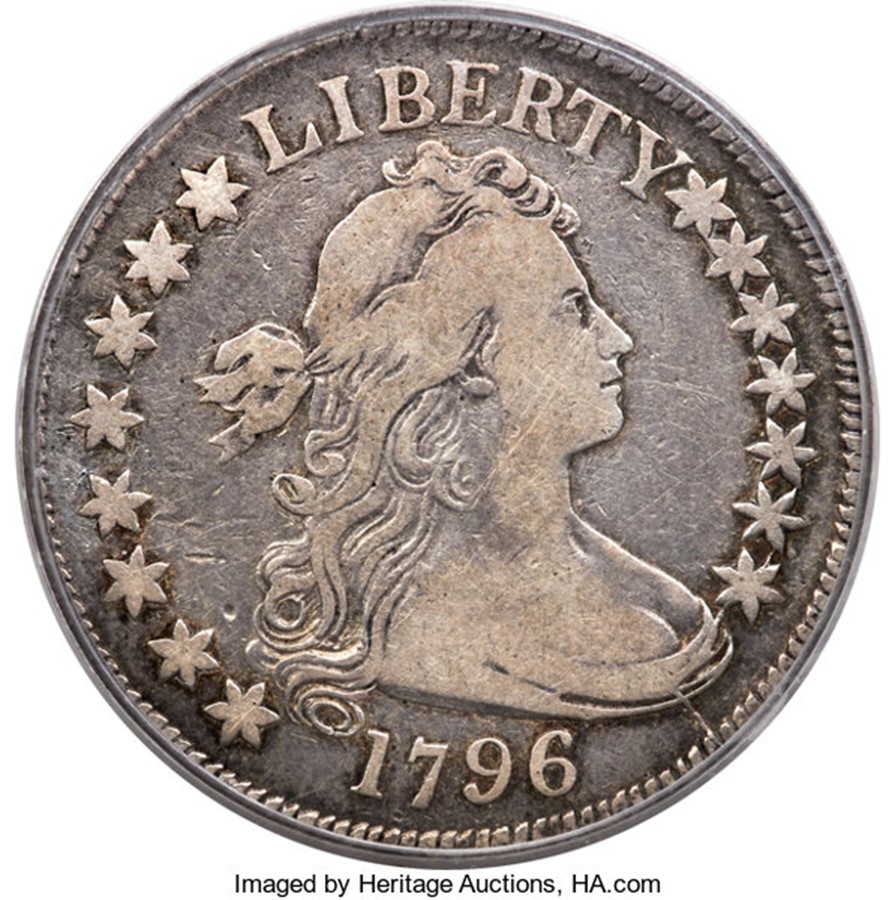
Draped Bust obverse, Small Eagle reverse half dollars constitute the rarest design type of all series of U.S. silver coins. Research by the late Jon Amato has demonstrated that there are far more around than researchers previously thought there could be. Twenty years ago, it was often stated that around three hundred survive, maybe 350. Now, it seems that there could be more than five hundred. Because half dollars are so popular, coins of this type have been relatively expensive ever since the coin collecting boom of the late 1850s.
Many Draped Bust, Small Eagle half dollars have been artificially toned or otherwise doctored. I suggest consulting an expert before acquiring one of these. Of course, it is safer on average to acquire a CAC approved coin.
Although this is a two year type and all of them were struck in Philadelphia, there are major varieties. For the purpose of a type set, the date and variety of a half of this type need not be a consideration. Market levels for each variety of this type are similar.
On January 21, 2021, Heritage auctioned a CAC approved Fine-15 grade 1796, fifteen stars obverse, half for $51,600. Heritage had auctioned this exact same coins in March 2011 for $74,750, when market levels for rare silver coins were higher than they were in January 2021.
On January 9, 2020, Heritage auctioned a CAC approved VF-20 grade 1797 half dollar for $57,600. Heritage had auctioned this exact same coin for $67,562.50 in August 2016.
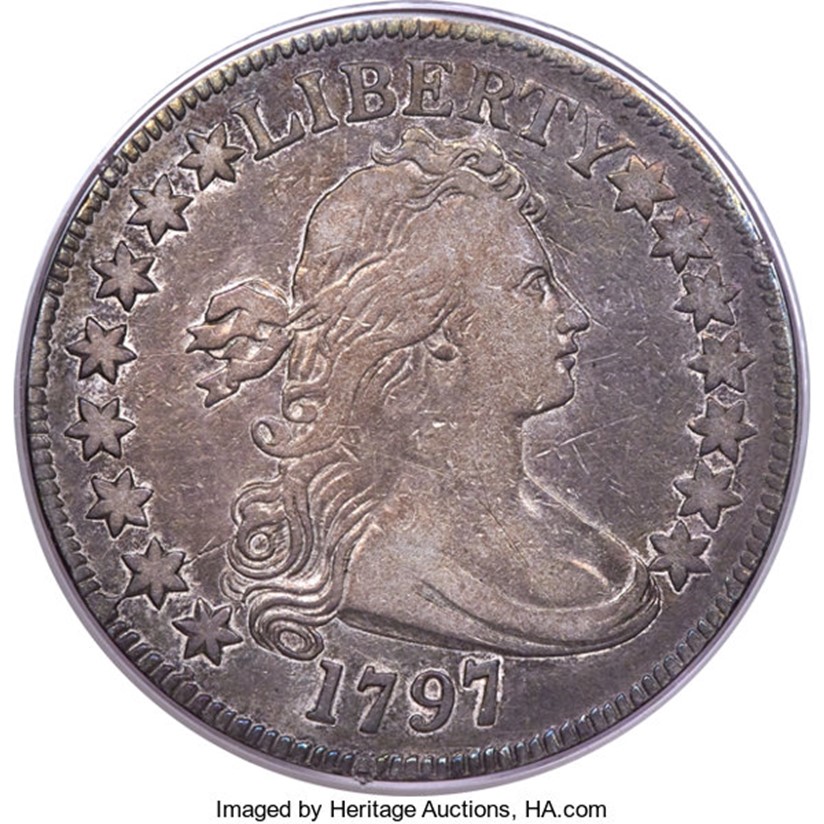
On August 1, 2021, GreatCollections sold a CAC approved, PCGS graded VF-30 1797 half for $90,001.12. GreatCollections previously sold the same coin in the same old holder on January 10, 2020, for $86,062.50.
There is an excellent chance that a pleasant, Very Fine grade half of this type could be purchased for less than $100,000, in late 2021 or during 2022. A higher grade coin would be likely to cost much more than $100,000. A CAC approved 1796 or 1797 half in the AU grade range may retail for well over $200,000.
Type #1 – Flowing Hair (1794-95)
For a type set, collectors usually select a 1795 rather than a 1794 half dollar. Many guides classify 1795 halves by major variety. For the purpose of acquiring a coin for a type set, however, it does not make a difference as to whether there are two leaves under each wing or three leaves under each of the eagle’s wings. Moreover, collectors assembling type sets typically do not pay premiums for representatives of die pairings that are rare. The fact that some other collectors will pay premiums, tremendous premiums on occasion, for rare die varieties does affect prices realized in auctions.
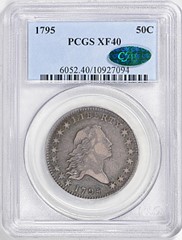
It is easy to find a VF to XF grade 1795 half dollar. On July 23, 2021, the firm of Scotsman auctioned a CAC approved, PCGS graded VF-20 1795 half for $3776. On April 22, 2021, Heritage auctioned a CAC approved, NGC graded VF-30 1795 half for $4560. On June 9, 2019, GreatCollections sold a CAC approved XF-40 grade 1795 half for $10,176.10. In a retail situation in 2021 or 2022, however, a dealer would be likely to ask for at least $11,000, possibly much more, for a CAC approved XF-40 grade 1795 half dollar. VF to AU grade 1795 half dollars are sold privately more so than in auctions.
It is very much practical to assemble a CAC-only type set of classic half dollars with all coins grading in the VF-20 to AU-55 range. I suggest discussing relatively expensive coins with experts before effecting purchases. Half dollars have always been very popular with coin collectors in the United States, and the array of designs is entertaining. After completing a type set, a collector may wish to think about collecting one or more types ‘by date’ or about assembling a type set of a different denomination, perhaps of quarters or of $10 gold coins (eagles).
Images are copyrighted by Gerry Fortin, Great Collections, and Heritage Auctions.
Copyright © 2021 Greg Reynolds
About the Author
Greg is a professional numismatist and researcher, having written more than 775 articles published in ten different publications relating to coins, patterns, and medals. He has won awards for analyses, interpretation of rarity, historical research, and critiques. In 2002 and again in 2023, Reynolds was the sole winner of the Numismatic Literary Guild (NLG) award for “Best All-Around Portfolio”.
Greg has carefully examined thousands of truly rare and conditionally rare classic U.S. coins, including a majority of the most famous rarities. He is also an expert in British coins. He is available for private consultations.
Email: Insightful10@gmail.com

